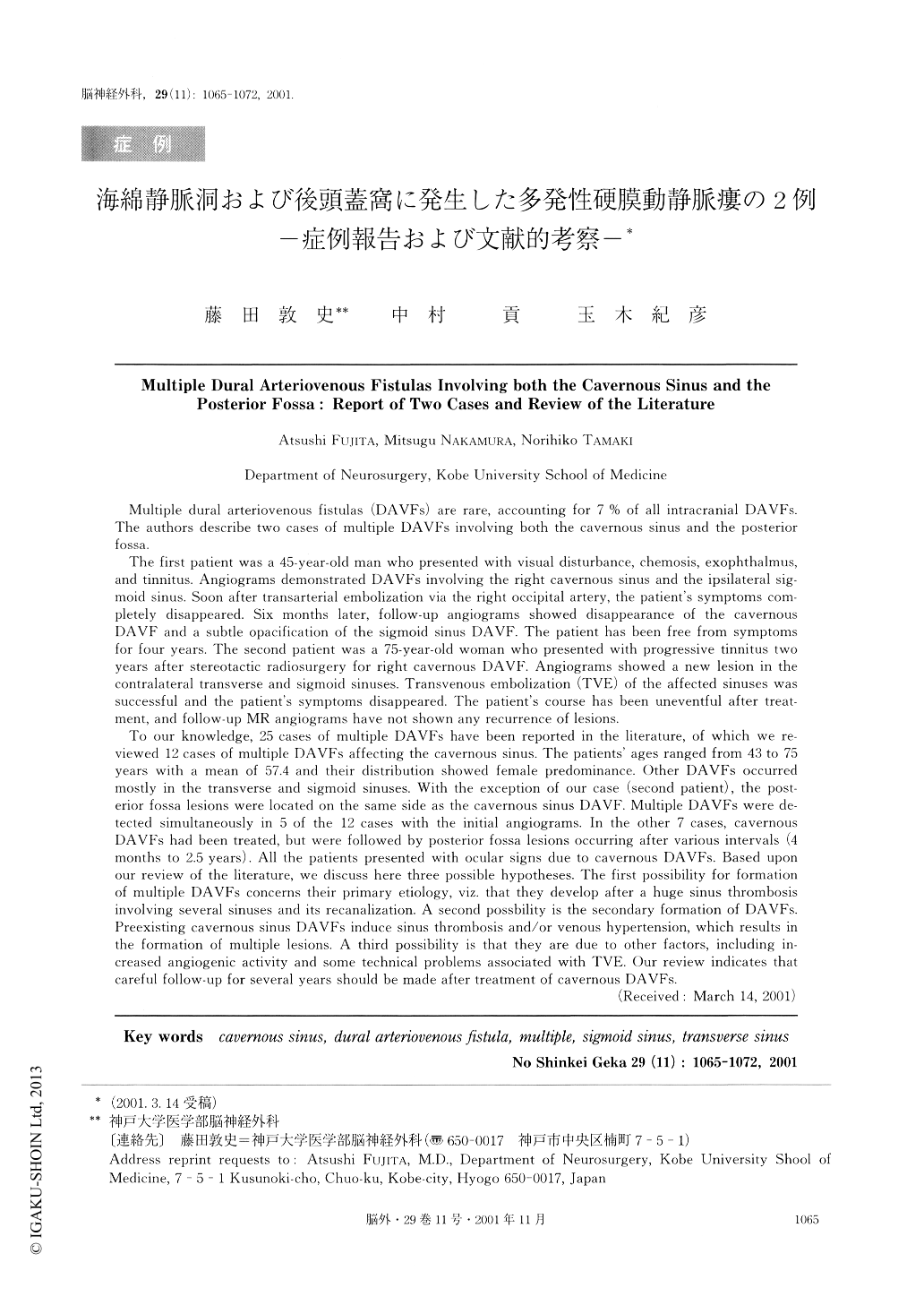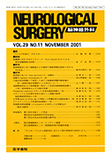Japanese
English
- 有料閲覧
- Abstract 文献概要
- 1ページ目 Look Inside
I.はじめに
硬膜動静脈瘻(以下DAVF)は横・S状静脈洞,海綿静脈洞(以下CS)に好発し15),そのほとんどは単発病変で多発性に発生することは稀である3).発生機序としては後天的要因が考えられているが,いまだ正確な発生機序が解明されておらず,多発性DAVFに関する報告も少ない2,3,5,8-10,12-14,16-21,26).これらの報告の中には,同時期に多発病変を診断した症例以外に,一病変の治療後に遅発性に他病変が発生した症例を含んでおり,これらを多発発生とすべきか再発とすべきか報告者により統一されていない.われわれは,CSおよび後頭蓋窩それぞれにDAVFを認めた2症例を経験した.これらの症例は多発病変を同時に診断した症例と,遅発病変が反対側に発生した症例であった.2症例を呈示するとともに,これまでの多発性DAVFの報告例を検討し文献的考察を加える.
Multiple dural arteriovenous fistulas (DAVFs) are rare, accounting for 7% of all intracranial DAVFs.The authors describe two cases of multiple DAVFs involving both the cavernous sinus and the posteriorfossa.
The first patient was a 45-year-old man who presented with visual disturbance, chemosis, exophthalmus,and tinnitus. Angiograms demonstrated DAVFs involving the right cavernous sinus and the ipsilateral sig-moid sinus. Soon after transarterial embolization via the right occipital artery, the patient's symptoms com-pletely disappeared. Six months later, follow-up angiograms showed disappearance of the cavernousDAVF and a subtle opacification of the sigmoid sinus DAVF. The patient has been free from symptomsfor four years. The second patient was a 75-year-old woman who presented with progressive tinnitus twoyears after stereotactic radiosurgery for right cavernous DAVF. Angiograms showed a new lesion in thecontralateral transverse and sigmoid sinuses. Transvenous embolization (TVE) of the affected sinuses wassuccessful and the patient's symptoms disappeared. The patient's course has been uneventful after treat-ment, and follow-up MR angiograms have not shown any recurrence of lesions.
To our knowledge, 25 cases of multiple DAVFs have been reported in the literature, of which we re-viewed 12 cases of multiple DAVFs affecting the cavernous sinus. The patients'ages ranged from 43 to 75years with a mean of 57.4 and their distribution showed female predominance. Other DAVFs occurredmostly in the transverse and sigmoid sinuses. With the exception of our case (second patient), the post-erior fossa lesions were located on the same side as the cavernous sinus DAVF. Multiple DAVFs were de-tected simultaneously in 5 of the 12 cases with the initial angiograms. In the other 7 cases, cavernousDAVFs had been treated, but were followed by posterior fossa lesions occurring after various intervals (4months to 2.5 years). All the patients presented with ocular signs due to cavernous DAVFs. Based uponour review of the literature, we discuss here three possible hypotheses. The first possibility for formationof multiple DAVFs concerns their primary etiology, viz. that they develop after a huge sinus thrombosisinvolving several sinuses and its recanalization. A second possbility is the secondary formation of DAVFs.Preexisting cavernous sinus DAVFs induce sinus thrombosis and/or venous hypertension, which results inthe formation of multiple lesions. A third possibility is that they are due to other factors, including in-creased angiogenic activity and some technical problems associated with TVE. Our review indicates thatcareful follow-up for several years should be made after treatment of cavernous DAVFs.

Copyright © 2001, Igaku-Shoin Ltd. All rights reserved.


